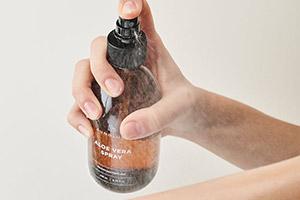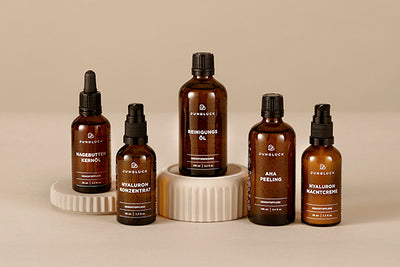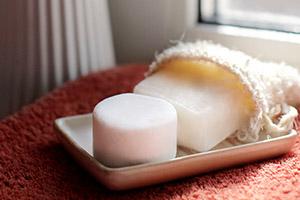This year, we have added a pure BHA peeling to our range. Therefore, we would like to take a closer look at the effects and benefits of salicylic acid. In addition, we would like to clarify what the difference is to our AHA peeling and also, when you should best use which peeling.
You can find out more about this in the article
1 What exactly is BHA?
2 How does salicylic acid work on the skin and for whom is it suitable?
3 What should I be aware of when using salicylic acid?
4 AHA or BHA? Which product is right for my skin?
5 How and where to apply the BHA peeling?
1 What exactly is BHA?
If you deal a lot with skincare, then you probably already know what the abbreviation BHA stands for. Or at least you've heard about it. Here the basic facts for the sake of completeness: BHA means beta hydroxy acid. It belongs to the fruit acids, just like AHA the alpha hydroxy acids. These include for instance glycolic acid, malic acid and lactic acid. Beta hydroxy acid, on the other hand, is better known as salicylic acid. We will explain later what the difference is here. You will also learn for which purposes you should use which fruit acid.
First of all, let's talk about BHA - but let's stick to the technical terminology: salicylic acid. It is a secondary plant substance that has its task in nature as a messenger substance. Salicylic acid is mainly found in willow bark but also in meadowsweet and it is also extracted from these plants. Nowadays, however, it is also produced synthetically. Because of its pain-relieving and anti-inflammatory effect, salicylic acid can be found in many areas of application. For example, one of its relatives, acetylsalicylic acid, is very well known as the drug aspirin.
Salicylic acid itself is one of the oldest medicinal ingredients and has quite a lot of side effects in higher doses. Therefore, it is only used externally these days to treat acne, psoriasis, warts, keratosis disorders on the skin, and rheumatism.
2 How does salicylic acid work on the skin and for whom is it suitable?
As mentioned before, salicylic acid plays an important role in the dermatological and skincare sector. But how does salicylic acid work?

Let's take a closer look at its great qualities:
- lipophilic, that means fat-loving
- is deeply absorbed by the skin and pores
- anti-inflammatory
- soothes the skin
- removes dead skin cells
- unclogs pores
This combination of qualities makes salicylic acid a good choice for all skin types. You may also be wondering whether salicylic acid is the right active ingredient for your skin?
Especially impure skin and skin that tends to have mild acne benefits from the use of salicylic acid. But sensitive, reddened skin and even rosacea sufferers can also discover a real skincare favorite here.
Pure skin
Salicylic acid works wonderfully against impurities and blackheads. Because of its fat solubility, it enters deeply (deeper than AHA) into our pores and clears them of deposits and dirt. At the same time, it fights cornification and thus improves the drainage of sebum. In addition, it also has an anti-inflammatory effect By doing so, it prevents the further development of pimples and pustules and noticeably soothes the skin's appearance.
Youthful complexion
Because salicylic acid accelerates the exfoliation of our skin and thus stimulates our natural cell renewal, it supports the skin in regenerating itself more quickly. Our complexion looks younger, fuller and noticeably smoother.
Powerful radiance
Salicylic acid also fights against a dull and sallow appearance of the skin. It removes dead skin cells from our top layer of skin and brings out the fresh skin cells.
Bye-bye redness
Yep, salicylic acid is also a great ingredient for sensitive skin. Due to its anti-inflammatory properties, it can soothe the skin and reduce irritation. Of course, this is beneficial for blemishes and acne. But salicylic acid can also provide relief for rosacea, which is also an inflammatory skin condition.
The areas of application of salicylic acid are therefore very diverse. Of course, it depends very much on the concentration used:
- Pimples and blackheads
- Keratosis pilaris
- Cornifications and calluses
- Milia
- Warts
- Psoriasis
While between 0.5 % and 2 % salicylic acid is used in skincare products, formulations that are individually prescribed by a doctor can sometimes contain up to 25 %.
3 What should I be aware of when using salicylic acid?
Allergy to acetylsalicylic acid
As touched on at the beginning, salicylic acid is one of the oldest active ingredients we use in medicine. Nevertheless, there are circumstances in which caution is necessary.
Especially if you are allergic to acetylsalicylic acid (aspirin), you should stay away from products containing salicyl. As the name suggests, these two substances are closely related and can have unpleasant side effects.
This is something you should know about.
Pregnancy and lactation
You should also be careful with the concentration of salicylic acid during pregnancy and lactation, as it can be absorbed into the body's tissues and bloodstream. As always, the dose is crucial here. Products with up to 2 % salicylic acid that are applied on small areas are also considered safe during pregnancy. Nevertheless, we advise you to briefly consult the responsible doctor. After all, only he or she can judge what is best for you individually.
4 AHA or BHA? Which product is right for my skin?
So basically, it can be said that customers with oily, impure skin and skin prone to acne should use BHA. This is because it unclogs pores and counteracts inflammation. However, due to its inflammation-relieving effect, BHA is also quite suitable for clients with rosacea. While if you have dry or mature skin, you should prefer the AHA peeling. AHAs have a hydrating effect on the skin and also care for wrinkles and pigmentation marks.

Our AHA peeling contains an additional 0.8% salicylic acid, which makes it a good all-rounder. However, if you don't tolerate the AHA peeling because your skin is too sensitive, then you could make a new friend with the BHA peeling. It is much more gentle and has a soothing effect.
Both peelings exfoliate the skin (AHA more than BHA), making a dull complexion glow.
5 How and where to apply the BHA peeling? Frequency, quantity, combinations
Like the AHA peeling, you should apply BHA products after thoroughly and gently cleansing your face. Our cleansing oil is a good choice for this.

THE RIGHT ORDER – Layering
Here you can learn more about how and in which order you can best apply our products.
Now that your face is free of dirt and debris, it's time for the BHA peeling. Put a few drops in the palm of your (washed) hand, rub your hands together, and apply a thin layer of the peeling to your face and décolleté. Avoid the eye area. Daily application can be optimal for individual skin requirements, but you may also do well with 2-3 times a week.
Afterwards, you can continue with your routine as usual. The peeling can also easily be combined with all other products.
Make sure to wear sunscreen
If you use a fruit acid peel, whether AHA or BHA, always apply sunscreen during the day. Removing dead skin cells reveals young, fresh cells that need that extra protection from UV rays.
Here is a summary of the key points:
- slowly accustom the skin (1-2x per week at the beginning).
- apply after cleansing
- allow to absorb
- simply continue with your routine
- can be easily combined with other products
- apply daily or 2-3 times a week as needed
- do not forget sun protection
- consult a doctor during pregnancy and lactation.

OUR BHA PEELING
This will take you directly to the BHA peeling. Take a look and learn more about the application and its ingredients.
I hope I have been able to introduce you to this wonderful active ingredient and show you whether it is right for you and your skin.
Take care

Sources
3 Acne vulgaris - AMBOSS. (2020). Amboss. https://www.amboss.com/de/wissen/Acne_vulgaris
4 Psoriasis vulgaris - AMBOSS. (o. D.-a). Amboss. Abgerufen am 12. Januar 2021, von https://www.amboss.com/de/wissen/Psoriasis_vulgaris
5 Bitte Geduld! (2020, 26. Januar). DAZ.online. https://www.deutsche-apotheker-zeitung.de/daz-az/2014/daz-21-2014/bitte-geduld





Leave a comment